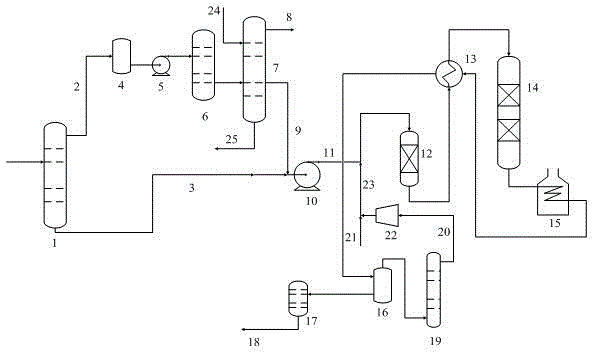A method for catalytic gasoline deep hydrodesulfurization
A technology of catalytic gasoline and deep hydrogenation, which is applied in the fields of hydrotreating process, petroleum industry, and hydrocarbon oil treatment, etc. It can solve the problems of poor adaptability of raw materials and different process flow, and achieve the reduction of octane number loss and good technical effect , the effect of low active metal content
- Summary
- Abstract
- Description
- Claims
- Application Information
AI Technical Summary
Problems solved by technology
Method used
Image
Examples
Embodiment 1
[0036] Catalytic gasoline is firstly subjected to a pre-fractionation tower to obtain light fractions and heavy fractions. The separation temperature of the light fractions and heavy fractions is 122°C; the light fractions are deodorized without alkali, and then enter the hydrogenation pre-fractionation tower for separation. The resulting light gasoline and The split temperature of medium gasoline is 66°C. The pre-hydrogenation reaction conditions are: hydrogen partial pressure 1.8MPa, volume space velocity 3.8h -1 , The reaction temperature is 178°C; the hydrodesulfurization reaction conditions are: hydrogen partial pressure 1.6MPa, volume space velocity 2.8h -1 , The reaction temperature is 285°C; the total hydrogen to oil volume ratio is 360:1. The alkali-free deodorization conditions are: the operating pressure of the reactor is 0.6MPa, the reaction temperature is 35°C, and the feed space velocity is 0.9h -1 , air / feed volume ratio 0.7. The properties of raw oil and tes...
Embodiment 2
[0039] Catalytic gasoline is firstly subjected to a pre-fractionation tower to obtain light fractions and heavy fractions. The separation temperature of the light fractions and heavy fractions is 118°C; the light fractions are deodorized without alkali, and then enter the hydrogenation pre-fractionation tower for separation. The resulting light gasoline and The split temperature of medium gasoline is 65°C. The prehydrogenation reaction conditions are: hydrogen partial pressure 2.0MPa, volume space velocity 3.5h -1 , The reaction temperature is 183°C; the hydrodesulfurization reaction conditions are: hydrogen partial pressure 1.8MPa, volume space velocity 3.0h -1 , The reaction temperature is 288°C; the total hydrogen to oil volume ratio is 380:1. The alkali-free deodorization conditions are: the operating pressure of the reactor is 0.5MPa, the reaction temperature is 45°C, and the feed space velocity is 0.8h -1 , air / feed volume ratio 0.6. The properties of raw oil and test...
Embodiment 3
[0042] Catalytic gasoline is firstly subjected to a pre-fractionation tower to obtain light fractions and heavy fractions. The separation temperature of the light fractions and heavy fractions is 121°C; the light fractions are deodorized without alkali, and then enter the hydrogenation pre-fractionation tower for separation. The resulting light gasoline and The split temperature of medium gasoline is 70°C. The pre-hydrogenation reaction conditions are: hydrogen partial pressure 1.8MPa, volume space velocity 4.2h -1 , The reaction temperature is 180°C; the hydrodesulfurization reaction conditions are: hydrogen partial pressure 1.6MPa, volume space velocity 3.2h -1 , The reaction temperature is 279°C; the total hydrogen to oil volume ratio is 320:1. ; The conditions for alkali-free deodorization are: the operating pressure of the reactor is 0.5MPa, the reaction temperature is 40°C, and the feed space velocity is 1.1h -1 , air / feed volume ratio 0.6. The properties of raw oil a...
PUM
 Login to View More
Login to View More Abstract
Description
Claims
Application Information
 Login to View More
Login to View More - R&D
- Intellectual Property
- Life Sciences
- Materials
- Tech Scout
- Unparalleled Data Quality
- Higher Quality Content
- 60% Fewer Hallucinations
Browse by: Latest US Patents, China's latest patents, Technical Efficacy Thesaurus, Application Domain, Technology Topic, Popular Technical Reports.
© 2025 PatSnap. All rights reserved.Legal|Privacy policy|Modern Slavery Act Transparency Statement|Sitemap|About US| Contact US: help@patsnap.com

